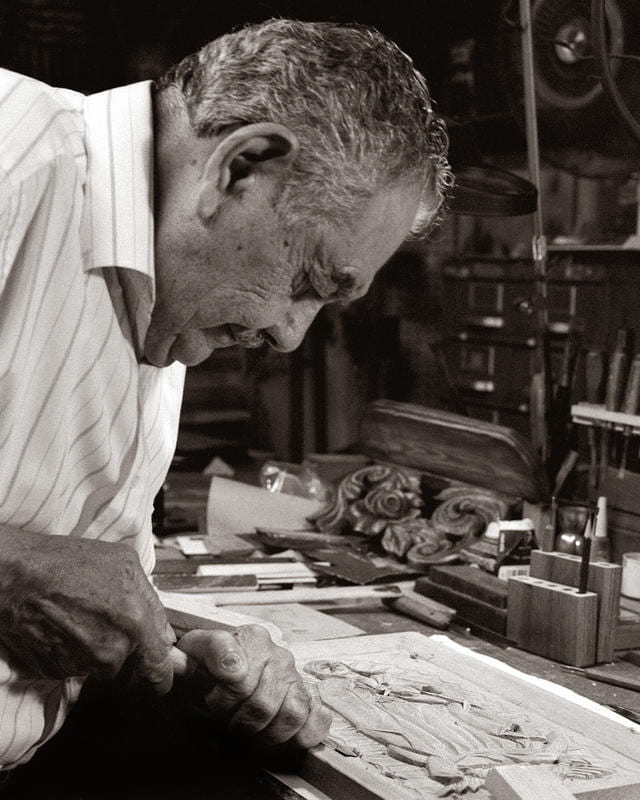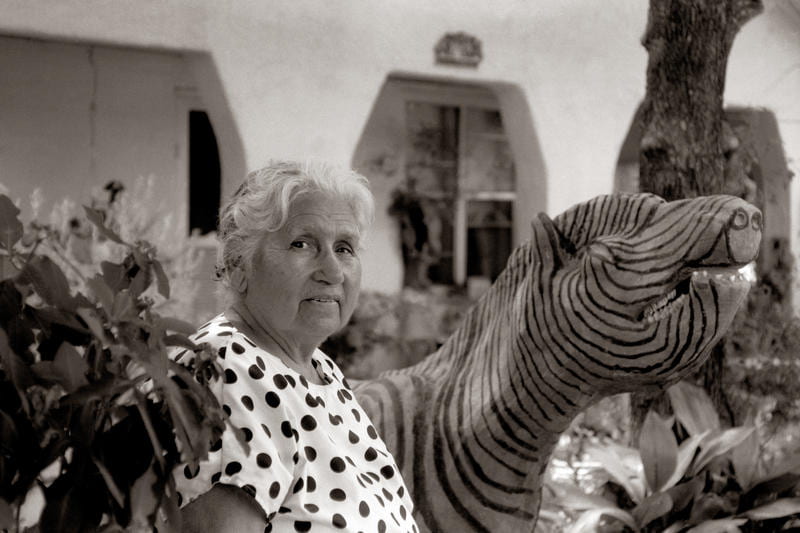The Elderly as Historical Agents of Their Dignity and Destiny
Infrastructure for a Time of Grace
Photos by Al Rendon, Rendon Photography & Fine Art
I called my great-grandmother “Abuelita,” a Spanish term of endearment for “grandmother.” She lived to the very old age of ninety-three. I fondly remember from my early childhood the vision of a fragile but sacred and venerable figure. She was not completely bed-ridden, she shuffled around the house in her slippers, cooked in the tiny kitchen, and swept both the floor and the dirt ground of the meager front yard. Visitors frequently came to her house, mostly uncles and aunts. She had one iron-clad rule: no English spoken in her house. She brooked no opposition.
One fateful day a few prohibited English words slipped from my little mouth. Abuelita rose up from her bed at the mere sound of the offensive language, gingerly set her gnarled feet on the well-trodden wood floor and grabbed her trusty wooden cane. Her bent figure menacingly approached me, her cane raised in a striking pose. In no uncertain terms, she spoke in Spanish the categorical imperative, “Do Not Speak English in this house!” She never hit me. Looking back, I see her as the self-appointed guardian of the language of the hearth under peril of the omnipresent tongue of the colonizer.
She intuited something like what the German philosopher Martin Heidegger said about language. Language is the house of being. In other words, language mediates the world to us. Worlds mediated by language are as qualitatively different from each other as the language that form them. In honoring the language of her ancestors and struggling to preserve it among her descendants, she revealed her historical agency in preserving the world as she knew and thereby exercised her dignity and actualized her destiny. Language is a representation of the world. Literature and art are representations of the world. To be is to be a representation. Fictional characters in literature and art represent the world not in theoretical discourse but in mood and emotion penetrating deeply into the core of truth shining a revelatory light on truth often inaccessible to discourse—especially when trying to penetrate difficult subjects such as old age and dying.
Marcus Tullius Cicero wrote an essay, “Cato Maior de Senectute,” or “On Old Age” (44 B. C.), closing with the pithy words that old age is the final act in the play of life. Delivering a homily in Rome on September 28, 2014, Pope Francis said that old age is a time of grace, a time when the prayers of the elderly are more powerful than that of younger generations.
Joining Cicero’s concept with Pope Francis’ results in a synthetic judgment that the final act of life is a time of grace, inversely, that the time of grace is the final act. Old age described as the final act emphasizes the finality, completeness and decisiveness of old age. Finality also connotes something as purpose-driven or goal-oriented. Cicero promotes the idea that there is meaningful purpose and purposeful meaning to old age.
Old age interpreted as a time of grace gives rise to an ambiguity in the latter term. From the standpoint of the subjective genitive, the accent of the time of grace falls on the subjective nature of grace and the objective quality of time, so that the time of grace means grace’s time, the era in which grace acts. On the other hand, accentuating the objective genitive, the time of grace becomes time’s grace, time’s gift of opportunity for gratuity and gracious of being and performativity during the final act.
Reflecting on these thoughts gives me the idea that the final act as a time of grace implies an ethical principle, namely, that the elderly ought to be the historical agents of their dignity and destiny. I say ‘ought to be’ rather than ‘are’ because it is not the case that most of Latin American elderly can be and should be the historical agents of their dignity and destiny and not the victims of a resigned fate.
Three old age characters in literature exemplify for me what it means to be the historical agent of your own dignity and destiny: the old colonel in Gabriel Garcia Márquez’ story, “No One Writes to the Colonel,” Carlos Fuentes’ fictionalized version of the elderly Ambrose Bierce in The Old Gringo, and Ernest Hemingway’s old Cuban fisherman in the Old Man and the Sea. As a counter point I will discuss the haunting image of the seated old woman in José Clemente Orozco’s 1926 mural, The Farewell.
The fictional old colonel in Gabriel Garcia Marquez’ short story, “No One Writes to the Colonel” is a paradigmatic figure of such a historical agent. An old colonel waits impatiently for a long-overdue and well-deserved pension check. Suffering the ravages of old age, the colonel is thin, bony, stiff and his gut feels like restless animals moving about. His wife suffers from progressive chronic asthma and says to him that she and the old colonel are rotting away. They climb into bed with empty and gnawing bellies. Their existences are marginal. They live at the edge of town in a small house. The aged, dried and worn-out house paint flakes off. The roof leaks, emblematic of the homes of the elderly poor.
The old colonel with Sisyphean patience waits despairingly for a pension that never arrives. His hope for salvation is a fighting cock bequeathed to him by his son. Corn and grain goes to the rooster, coffee for the old colonel and his wife.
The long-awaited and well-earned pension check never appears in the weekly mail delivery but that doesn’t stop the old colonel from regularly enquiring at the postal drop-off. Selling the rooster seems to be their only alternative to avoid starvation, the symbol of their salvation. Religion, the rosary, is the wife’s only solace, the rooster the old colonel’s. In an act of desperation, the old asthmatic starving woman grabs her husband, shakes him and yells in exasperation, “What shall we eat?” “Shit!” boldly replies the old colonel.
It seems an ignoble way to end such a sad story about desperately poor old people! But I don’t think that this is an ignoble ending, maybe ironic but not ignoble. The word “shit” expresses the old colonel’s affirmation of their own dignity in the face of life’s deprivations, the negations of human existence. Decisively, in a moment of revelation—a time of grace—the old colonel takes firm hold of the reins of their own destiny, or at least his own, and ironically asserts their dignity by uttering “Shit!” The real sustenance is not food but hope, hope sustains life. Philosopher Benedict Spinoza in Book 3 of his Ethics expresses a universally valid proposition that every entity endeavors (from the Latin conatus) to preserve its own existence. This statement essentially expresses the motivation of historical agency and unmistakably entails self-preservation as a basic and natural human right.
Consider Carlos Fuentes’ popular novel The Old Gringo narrated from the first-person perspective of a woman, presumably Harriet Winslow, the young woman with whom the old gringo fell in love. She remembers that the old gringo came to Mexico to die.
The figure of the old gringo was partially inspired by Ambrose Bierce, the Hearst journalist who mysteriously disappeared in Mexico during the revolution begun in 1910. Bierce had fought in the U.S. Civil War and probably died in Mexico during the Mexican Revolution. Fuentes placed in the old gringo’s mouth the words, “To be a gringo in Mexico, Ah, that is euthanasia.” Fuentes probably imagined that Bierce’s psychological motivation for going to Mexico was to die both a death of his own choosing and, at the same time, a deserved death.
A retired journalist, well-traveled and tired, finished with his work, the old gringo went to Mexico to die at the hands of Pancho Villa by firing squad—a good way to die, he decided, a version of suicide by cop. Doggedly determined to assert his dignity and secure his destiny in his own way, the old gringo grabbed the reins of his historical teleological inevitability. Tellingly, his only prized possession was a copy of Cervantes’ Don Quixote. By association, Fuentes unreservedly depicts Bierce as a modern-day Don Quixote on a fantastic quest to die the good death.
His journey reaches a crucial turning point when he meets the self-styled general Tomás Arroyo and announced that he wanted to join forces with Villa and fight. The general laughed saying that he was too old, but reluctantly added him to his cohort after a demonstration of marksmanship. Soon, the old man learned that general Arroyo claimed to have papers proving that the hacienda that he occupied was his patrimony. The old man felt moral outrage because the general fought for his own selfish interests and not for the ideals of the Mexican Revolution.
Fueled by rage against the base corruption of revolutionary ideas, the old man burned Arroyo’s prized land grant papers. For this unconscionable transgression, Arroyo shot the old gringo in the back. Ironically, the old gringo sacrificed himself for the airy ideal of ideals, that ideals ought to be lofty and followed faithfully. Ironically, the old gringo died his longed-for death for the failure of another’s falling short of the old gringo’s ideal. Yet, did he not prove the historical agency of his dignity and destiny? Ah! To be a gringo in Mexico, that is euthanasia!
Ernest Hemingway’s modern classic The Old Man and the Sea also carries a potent message about the elderly’s pressing need to be the historical agents of their dignity and destiny. What I mean by dignity is what Immanuel Kant, the 18th-century German philosopher, expressed in the second formulation of his categorical imperative: One ought always to treat the other human beings as ends in themselves and never as a means. Formulated differently, his words can be rendered in more modern language as: Respect the inherent worth of each person. The elderly, like Santiago, the old fisherman, hope to gain and preserve not just their existence but their dignity. Dignity begins and ends with historical agency.
As I see it, the sea in Hemingway’s novel is a metaphor for the struggle of existence, for the philosophers Arthur Schopenhauer’s will-to-live and Nietzsche’s will-to-power. Human existence so vulnerable to innumerable risks and dangers constantly faces threatening forces from within and without, exponentially true in old age than any other age.
The skinny elderly Cuban fisherman wrinkly, blotchy and with scarred hands, wore the badges life awarded for exposure to the blaring sun, the handling of the ropes, oars, fish hooks, bait and flotsam and all the accoutrement of the fisherman’s craft.
The old man’s only lifeline was a loyal young boy, Manolin, whom he taught the fisherman’s craft. But, day after day, for eighty-four days, he returned from the sea empty-handed. After forty days of this, the boy’s family prohibited him from going out to sea anymore with the old man. The other fisherman called him unlucky. Old age is like that for many—being unlucky, feeling empty-handed. But, the fisherman, like the old colonel and the old gringo, was determined to prove his self-worth. One propitious morning, he set off to sea in his skiff with the sole objective—returning with the big one, a marlin. To himself, he thought that his big fish must be out there in the sea somewhere, the fish that would represent the substance of his dignity and the evidence of his worth.
After hours at sea he noted the marlin swimming steadily and slowly on clam waters. The baits were in the water. He waited uncertainly wishing the youth was with him. Like old people everywhere, his longing for the youth is the near-universal desire of the elderly to be young again and for the assistance of the young partly to compensate for thinning bones, dimming eyes, toothless smiles, stiff knees, creaking hips, sclerotic backs and deaf ears.

The marlin takes the bait. Elated but in a state of anxiety he fears that the big fish might drag him down deep in despair and the abyss of death. Having victoriously caught the great marlin, the old man securely and expertly ties it to the side of the boat. Sharks, however, constantly attacked the marlin biting chunks of flesh until there was nothing but a skeleton. He returned victoriously but regrettably with only a skeleton to show for his hard-won struggle. Back at his palm leaf covered beach shack, he fell asleep. The boy awakened him, but the old man returned to sleep and dreamed of lions. Tied to the side of the skiff beached on shore, the marlin’s large skeleton elicited glowing admiration from the knowing village fisherman.
The famous Mexican muralist José Clemente Orozco, at the request of José Vasconcelos, the minister of education and philosopher, painted his first mural on the Great Patio of the Escuela Nacional Preparatoria (ENP), formerly El Colegio de San Idelfonso (1923). In 1926, Orozco returned to finish the murals he started in 1923 and to repair and repaint murals that reactionaries had defaced a few years earlier. On the second floor, stands the mural entitled Despedida, [Farewell] also known as Stoicismo, [Stoicism]. A disconsolate old woman wrapped in a white dress and wearing a white hood, sits resignedly on the ground at the intersection of two streets at whose corner stands a nondescript house. Standing before her is the stout figure of a man, presumably her son or grandson, in military uniform. Bending forward, he is gently kissing the back of her weak hand. A second soldier is saying farewell to another seated and sorrowful woman.
The soldiers are ready to move, movement is their atmosphere, they stand ready to move, and they bend. The old woman in white is static; orientalized, she is frozen in time, representing the past. Almost lacking three-dimensionality, the seated old woman is sculpted and not merely sketched, but her spatiality is not as robust as the soldier’s. Orozco gives the young soldier mass, magnitude, depth and the solid impression of three-dimensionality. Like the material reality of a granite stone, the image of the young soldier stands in deep contrast to the almost eerie and phantomlike quality of the mother or grandmother.
A similar composition with the repetition of the same seated old woman appears in a 1929 lithograph Esquina de casa y figuras [Corner of a House and Figures]. The powerful interplay of black and white figures stands out dramatically. They are juxtaposed like contrasting light and shadow for a bold, emotional chiaroscuro effect. The backdrop of the figures is formed by the corner lines of the building. From the top of the vertical line in the center of the composition two lines proceed downward creating congruent but opposite angles framing the figures in the foreground adding spatiality and suggesting the linearity of time pointing simultaneously both to the past and to the future.
Admittedly, the seated old woman does not readily suggest historical agency, but resignation to fate. Both representations picture farewell scenes, but more is going on than merely saying goodbye. On the one side the old colonel, the old gringo, and the old fisherman in sundry ways robustly fight for their dignity and impose their individual wills on the slipperiness of capricious human existence. On the other, the old woman sits on the ground unable or unwilling to stand surrendering her desire to the inevitability of what she cannot change. Are historical agency and resignation to fate equally possible, mutually exclusive and jointly exhaustive options? For some, feasibility rules out the possibility of choice. For others, choice is a live option. In any case, an ethical bird’s eye view, the social-political standpoint, recognizes an obligation to construct the liberating conditions for the historical agency of the elderly.
Winter 2019, Volume XVIII, Number 2
Michael Candelaria (Harvard, Th.D., 1987) is Principal Lecturer in the Philosophy Department and the Religious Studies Program at the University of New Mexico in Albuquerque. He is the author of the recent book, The Latino Christ in Art, Literature, and Liberation Theology.
Related Articles
Video Interview with Flavia Piovesan
Flavia Piovesan is a member of the Inter-American Commission on Human Rights, Professor of Law at the Pontifical Catholic University of São Paulo and 2018 Lemann Visiting Scholar at the…
Aging: Editor’s Letter
There is no smell of pungent printers ink permeating my office. My interns—Sylvie, Isaac and Marc—are not scrambling to find FedEx boxes to send out ReVista issues to authors and photographers all over the world. I cannot feel the silken touch of the printed page…
A Story of Agricultural Change
Francisca Hernández García, 92, lives in San Miguel del Valle, a town of around 3,000 inhabitants in the Central Valleys of Oaxaca, an hour east of the capital city. She is one of the few remaining…
















